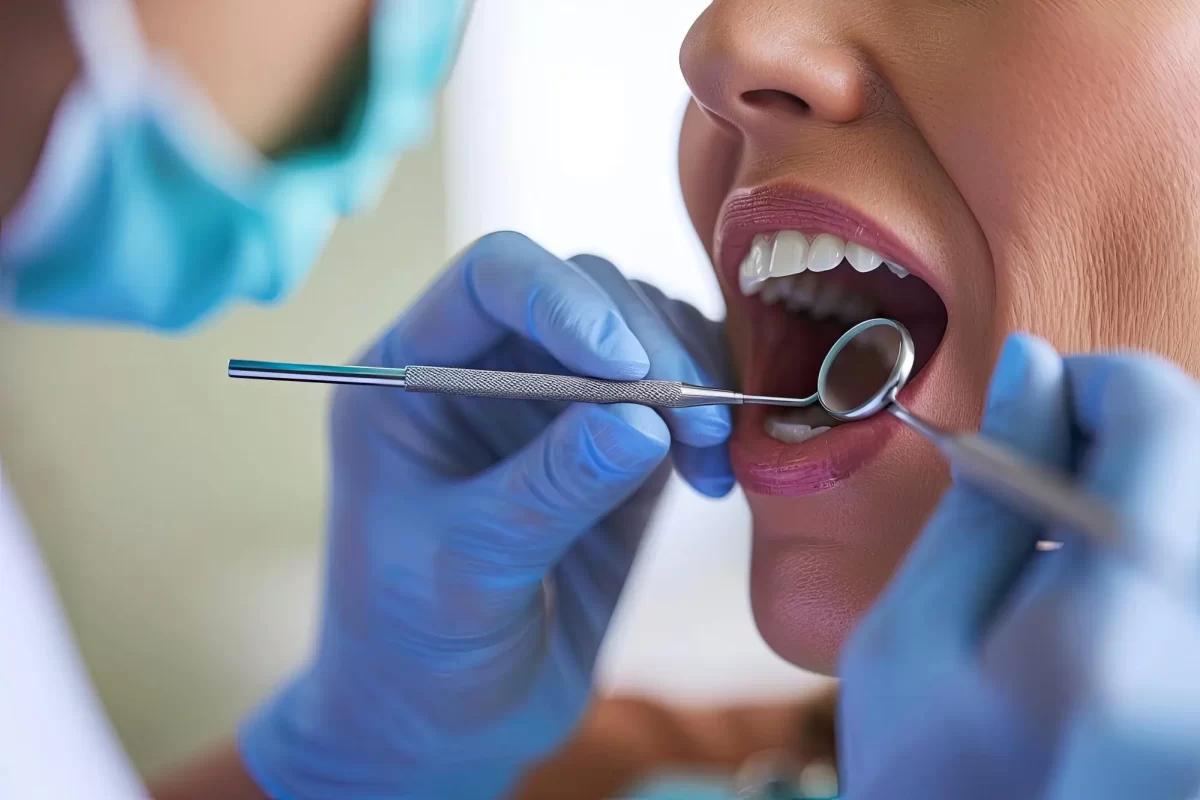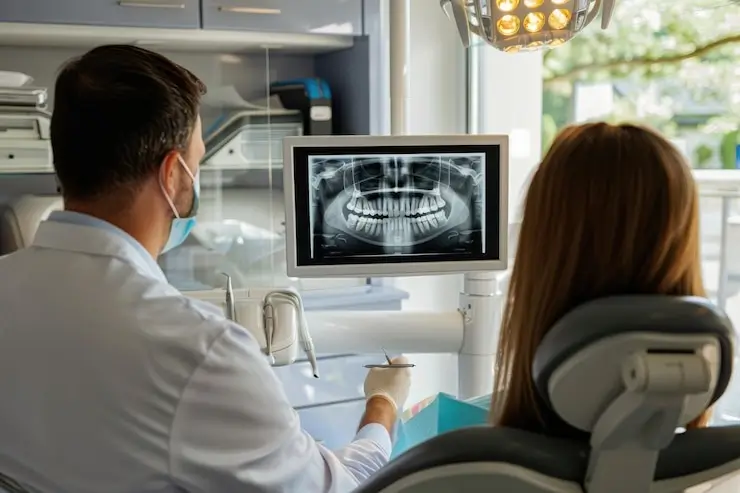Dental practices have evolved significantly over thousands of years, yet one persistent challenge remains: how do we maintain optimal oral health? The conventional dental approach primarily emphasizes the prevention and repair of cavities, while the biomimetic dentistry approach takes a different route by aiming to maintain balance in the mouth, thereby preventing issues before they arise.
In contrast to traditional methods that often rely on crowns for restoration, biomimetic dentistry seeks to promote natural tooth health and function, reducing the need for invasive procedures. Here we are going to talk about biomimetic dentistry vs crown.
What is exactly Biomimetic Dentistry?
Biomimetic dentistry is an innovative approach that seeks to restore teeth in a way that closely mimics their natural structure and function. This technique emphasizes the preservation of healthy tooth tissue, utilizing advanced materials and methods that replicate the look, strength, and resilience of natural enamel and dentin.
By focusing on creating bonds between teeth and restorations that resemble biological properties, biomimetic dentistry aims to enhance the durability and longevity of dental restorations while also reducing the risk of decay and sensitivity. This patient-centered philosophy not only improves aesthetic outcomes but also promotes overall oral health by encouraging a conservative treatment approach.
Materials Used In Biomimetic Dentistry
Biomimetic dentistry stands out due to the unique materials used for tooth restoration. These biomimetic materials exhibit superior retention and closely mimic the appearance and properties of natural teeth, unlike many traditional dental materials.
Among the most commonly utilized materials in biomimetic dentistry are:
1. Calcium Phosphate Hydroxyapatite: Hydroxyapatite ceramics are employed in the creation of inlays, onlays, and crowns. Since natural teeth are composed of hydroxyapatite, these ceramics serve as an ideal substitute for damaged enamel.
2. Alumina: Also known as aluminum oxide, alumina ceramics are known for their exceptional strength and biocompatibility, allowing them to integrate well with the body’s tissues.
3. Glass Ionomer Cements: These cements have a hardness similar to dentin and exhibit excellent adhesion to natural teeth. This strong bond ensures that fillings stay in place, providing long-lasting durability over time.

What is Dental Crown?
Dental crowns are caps placed over significantly damaged, decayed, or weak teeth to restore their shape, size, strength, and appearance. While traditional crowned procedures require considerable alteration of the tooth structure—removing a substantial amount of the outer layer to create space for the crown—biomimetic dentistry offers a compelling alternative.
Unlike the conventional approach of dental crowns, which can be viewed as more invasive due to these extensive modifications, biomimetic dentistry emphasizes minimally invasive techniques that prioritize the preservation of natural tooth structure. This innovative approach not only aims to provide a protective cover but also seeks to replicate the properties of natural teeth, reflecting a philosophy that values conservation and restoration over the significant alterations associated with crown placement. In the debate of biomimetic dentistry vs crown procedures, the former stands out for its commitment to minimizing invasiveness while still addressing dental health concerns.

Difference between bio-mimetic dentistry and crown
Biomimetic Dentistry is an innovative approach to tooth restoration that focuses on mimicking the natural structure and function of teeth. Unlike traditional methods, biomimetic dentistry emphasizes conservation of healthy dental tissues and uses advanced materials that closely resemble natural teeth. This technique aims to restore teeth in a way that maintains their original strength, aesthetic appeal, and functionality while minimizing the need for invasive procedures.
In contrast, a Dental Crown is a common dental procedure used to cover and protect a damaged or decayed tooth. Crowns restore the tooth’s shape, size, strength, and appearance, but they often require significant alteration of the original tooth structure. This process can be considered less conservative than biomimetic techniques, as it usually involves the removal of a considerable amount of tooth material.
In terms of dental health, the biomimetic approach is often viewed as superior due to its preservation of tooth structure. It offers a more proactive solution to maintain dental health in the long term, as it reduces the likelihood of further decay or damage.
While both biomimetic dentistry and dental crowns serve the purpose of tooth restoration, biomimetic dentistry is a more conservative and naturalistic approach, emphasizing the preservation of healthy tooth material and the use of advanced materials that mimic the properties of natural teeth.
Why Should You Choose Biomimetic Dentistry?
Biomimetic dentistry is an innovative approach that focuses on mimicking the natural properties and functions of teeth, rather than merely repairing them. Here are several reasons why you might choose biomimetic dentistry:
1. Natural Aesthetics:
Biomimetic materials can closely resemble the color, texture, and translucency of natural teeth, providing a more aesthetically pleasing result compared to traditional dental materials.
2. Conservative Treatment:
This approach emphasizes minimally invasive techniques, preserving as much of the natural tooth structure as possible. This can lead to better long-term outcomes for your oral health.
3. Durability:
Biomimetic materials are designed to withstand the same stresses and strains as natural teeth. This can lead to longer-lasting restorations that reduce the frequency of repairs or replacements.
4. Better Bonding:
The materials used in biomimetic dentistry often provide better adhesion to tooth structures, which can help prevent further decay and improve the longevity of restorations.
5. Functionality:
The goal of biomimetic dentistry is to restore not just the appearance but also the function of the teeth. This means that the treated teeth can perform as naturally as possible, allowing for improved chewing and speaking.
6. Reduction of Sensitivity:
Restorations that mimic natural teeth can minimize post-treatment sensitivity, as they replicate the natural structure and function of the tooth.
7. Holistic Approach:
Biomimetic dentistry often takes into account the overall health of the patient, considering factors such as occlusion (bite) and jaw alignment, which can lead to more comprehensive treatment plans.
8. Less Risk of Secondary Decay:
By using materials that create a better seal and bond with the tooth, biomimetic dentistry can reduce the risk of secondary cavities around restorations.
9. Personalized Treatment:
This approach allows for customized treatment plans tailored to the specific needs and circumstances of individual patients, leading to more effective care.
10. Educational Focus:
Dentists who practice biomimetic dentistry often emphasize patient education, helping patients understand their oral health and the rationale behind their treatment choices.
Overall, if you value an approach that prioritizes the health and integrity of your natural teeth while offering effective, aesthetically pleasing results, biomimetic dentistry may be an excellent option for you. Always consult with a qualified dental professional to understand the best treatment options for your specific dental needs. In Fortunesmiles Dental clinic, we offer diverse services of biomimetic dentistry.
When is a crown necessary?
A dental crown may be necessary in the following situations:
- Severe Decay: When a tooth has extensive decay that cannot be repaired with a simple filling, a crown can restore the tooth’s shape and function.
- Root Canal Treatment: Teeth that have undergone root canal treatment often require a crown to provide strength and protect the tooth from fractures.
- Fractured or Cracked Tooth: If a tooth is significantly cracked or fractured, a crown can help stabilize it and prevent further damage.
- Large Fillings: When a tooth has a large filling that compromises its structural integrity, a crown may be necessary to provide additional support.
- Cosmetic Improvement: Crowns can also be used for cosmetic reasons, such as improving the appearance of discolored or misshapen teeth.
- Bridges: If a dental bridge is needed to replace one or more missing teeth, crowns are often placed on the adjacent teeth to anchor the bridge.
- Tooth Wear: In cases of significant wear due to grinding (bruxism) or erosion, a crown can help restore the tooth’s shape and function.
If you suspect you need a crown, it’s best to consult with a dentist for an evaluation and personalized recommendations. One of the great dental clinic in California is Fortunesmiles and here you can have your best experience of dentistry.

What are the benefits of biomimetic dentistry?
Biomimetic dentistry is transforming the way dental care is approached, and at Fortunesmiles Dental, a leading dental clinic in California, we are proud to incorporate these innovative techniques into our practice. Here are some key benefits of biomimetic dentistry that our patients can enjoy:
• Enhanced Aesthetics:
Biomimetic dentistry focuses on mimicking the natural structure and function of teeth. This means that treatments are designed to blend seamlessly with your existing teeth, resulting in a more aesthetically pleasing smile. At Fortunesmiles Dental, our biomimetic dentist prioritizes natural-looking results.
• Minimally Invasive Techniques:
One of the hallmark features of biomimetic dentistry is its emphasis on preserving as much of the natural tooth structure as possible. Our dental clinic in California utilizes techniques that are less invasive than traditional methods, which can lead to quicker recovery times and less discomfort for patients.
• Strength and Durability:
Biomimetic materials are designed to provide greater strength and durability compared to conventional dental materials. This means that restorations like crowns and fillings not only look great but also withstand the pressures of everyday use. At Fortunesmiles Dental, our biomimetic dentist ensures that your dental work is built to last.
• Biocompatibility:
Many of the materials used in biomimetic dentistry are biocompatible, meaning they are less likely to cause allergic reactions or other complications. Patients at Fortunesmiles Dental can have peace of mind knowing that we prioritize their health and safety.
• Long-term Oral Health:
By focusing on the preservation of natural tooth structure and using advanced materials, biomimetic dentistry promotes better long-term oral health. Our skilled team at Fortunesmiles Dental is dedicated to providing treatments that not only restore function but also protect your overall dental well-being.
Biomimetic dentistry cost
Biomimetic dentistry focuses on restoring teeth in a way that mimics their natural structure and function, often using advanced materials and techniques to preserve as much of the natural tooth as possible. The cost of biomimetic dentistry can vary widely depending on several factors, including:
1. Location: Dental practices in urban areas or regions with a higher cost of living typically have higher prices.
2. Dentist’s Experience: A dentist with specialized training in biomimetic techniques may charge more than a general practitioner.
3. Type of Treatment: Specific procedures, such as adhesive restorations, inlays, onlays, or other biomimetic approaches, will have different costs associated with materials and labor.
4. Insurance Coverage: Depending on your dental insurance plan, some biomimetic procedures may be partially covered, while others may not be covered at all.
As a rough estimate, conventional dental treatments such as fillings or crowns might cost anywhere from $100 to $1,500 or more, while biomimetic techniques could range higher, especially if they involve advanced materials or procedures. Consulting with a dentist who specializes in biomimetic dentistry will provide the most accurate information regarding potential costs.
Conclusion
In the realm of tooth restoration, selecting between biomimetic dentistry and dental crowns is a vital decision that hinges on various factors, including the extent of tooth damage, aesthetic requirements, and personal health goals. At Fortunesmiles Dental Clinic in California, we are dedicated to offering comprehensive assessments and customized treatment plans that reflect our commitment to both conservative and effective dental care.
Biomimetic dentistry offers an exciting, modern approach to conservation and restoration, bridging the gap between functionality and aesthetics. Patients enjoy improved dental health, fewer invasive treatments, and aesthetic outcomes that closely resemble their natural teeth. On the other hand, traditional crowns still possess valuable applications in specific circumstances, offering durable solutions for severely damaged teeth.
With the right information and a dedicated dental team, patients can make informed decisions about their restorative options, ensuring they achieve the healthiest, most radiant smiles possible. Whether they opt for biomimetic techniques or traditional crowns, rest assured that a tailored approach awaits at Fortunesmiles Dental Clinic, where your dental health and appearance are our top priorities.

